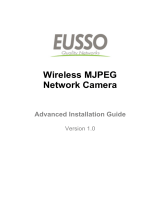
VIVOTEK
2 - User's Manual
Table of Contents
Overview.......................................................................................................................................................3
Read Before Use �������������������������������������������������������������������������������������������������������������������������������������3
Package Contents �����������������������������������������������������������������������������������������������������������������������������������3
Physical Description ��������������������������������������������������������������������������������������������������������������������������������4
Install Ferrite Core �����������������������������������������������������������������������������������������������������������������������������������6
Network Deployment �������������������������������������������������������������������������������������������������������������������������������8
Software Installation ������������������������������������������������������������������������������������������������������������������������������10
Ready to Use ����������������������������������������������������������������������������������������������������������������������������������������� 11
Accessing the Network Camera .................................................................................................................12
Using Web Browsers �����������������������������������������������������������������������������������������������������������������������������12
Using RTSP Players ������������������������������������������������������������������������������������������������������������������������������15
Using 3GPP-compatible Mobile Devices �����������������������������������������������������������������������������������������������16
Using VIVOTEK Recording Software ����������������������������������������������������������������������������������������������������17
Main Page ..................................................................................................................................................18
Client Settings ............................................................................................................................................22
Conguration ..............................................................................................................................................24
System ��������������������������������������������������������������������������������������������������������������������������������������������������25
Security �������������������������������������������������������������������������������������������������������������������������������������������������28
HTTPS (Hypertext Transfer Protocol over SSL) �����������������������������������������������������������������������������������29
SNMP (Simple Network Management Protocol) ����������������������������������������������������������������������������������34
Network �������������������������������������������������������������������������������������������������������������������������������������������������35
Wireless (IP8133W) ������������������������������������������������������������������������������������������������������������������������������49
Express Link ������������������������������������������������������������������������������������������������������������������������������������������58
DDNS ����������������������������������������������������������������������������������������������������������������������������������������������������59
Access List �������������������������������������������������������������������������������������������������������������������������������������������61
Audio and Video ������������������������������������������������������������������������������������������������������������������������������������64
Motion Detection �����������������������������������������������������������������������������������������������������������������������������������74
Camera Tampering Detection ���������������������������������������������������������������������������������������������������������������77
Homepage Layout ��������������������������������������������������������������������������������������������������������������������������������78
Application ��������������������������������������������������������������������������������������������������������������������������������������������81
Recording ���������������������������������������������������������������������������������������������������������������������������������������������97
System Log ����������������������������������������������������������������������������������������������������������������������������������������101
View Parameters ��������������������������������������������������������������������������������������������������������������������������������102
Maintenance ����������������������������������������������������������������������������������������������������������������������������������������103
Appendix ..................................................................................................................................................107
URL Commands for the Network Camera �������������������������������������������������������������������������������������������107
Technical Specications ����������������������������������������������������������������������������������������������������������������������159
Technology License Notice ������������������������������������������������������������������������������������������������������������������160
Electromagnetic Compatibility (EMC) ��������������������������������������������������������������������������������������������������161




















